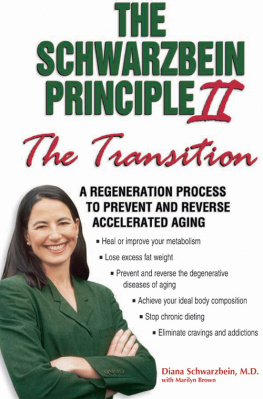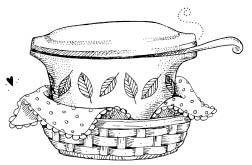
The Schwarzbein Principle
Cookbook THE
SCHWARZBEIN
PRINCIPLE
COOKBOOK Diana Schwarzbein, M.D.
Nancy Deville
and Evelyn Jacob Health Communications, Inc.
Health Communications, Inc.
Deerfield Beach, Florida
www.hcibooks.comThe Schwarzbein Principle Cookbook and the recipes contained in this book are not intended as a substitute for the advice and/or medical care of the readers physician, nor are they meant to discourage or dissuade the reader from the advice of his or her physician. The reader should regularly consult with a physician in matters relating to his or her health, and especially with regard to symptoms that may require diagnosis. Any eating or lifestyle regimen should be undertaken under the direct supervision of the readers physician. Moreover, anyone with chronic or serious ailments should undertake any eating and lifestyle program, and/or changes to his or her personal eating and lifestyle regimen, under the direct supervision of his or her physician. If the reader has any questions concerning the information presented in this book, or its application to his or her particular medical profile, or if the reader has unusual medical or nutritional needs or constraints that may conflict with the advice in this book, he or she should consult his or her physician. Library of Congress Cataloging-in-Publication Data Schwarzbein, Diana The Schwarzbein principle cookbook / Diana Schwarzbein, Nancy Deville and
Evelyn Jacob. p. cm. eISBN-13: 978-0-7573-9692-2 eISBN-10: 0-7573-9692-5 1. eISBN-13: 978-0-7573-9692-2 eISBN-10: 0-7573-9692-5 1.
Low-carbohydrate diet recipes. 2. Sugar-free diet recipes. I. Deville, Nancy. II.
Jacob, Evelyn. III. Title. RM237.73.S35 1999 99-26054 641.5'638dc21 CIP 1999 Diana Schwarzbein, M.D., Nancy Deville and Evelyn Jacob
All rights reserved. Printed in the United States of Amer ica. 3201 S.W. 15th Street Deerfield Beach, FL 33442-8190
HCI, its logos and marks are trademarks of Health Communications, Inc.
R-03-07
Cover design by Lisa Camp
Author photos by Alice WilliamsFor my mami,
Martha Schwarzbein, who sat with me
for many hours when I was a child,
trying to get me to eat! DIANA SCHWARZBEIN, M.D.
For Emma and Charlotte
for their boundless joy and love. NANCY DEVILLE
For my mom, Ghislaine Jacob,
my inspiration, and to my dad, Papa O. 15th Street Deerfield Beach, FL 33442-8190
HCI, its logos and marks are trademarks of Health Communications, Inc.
R-03-07
Cover design by Lisa Camp
Author photos by Alice Williams For my mami,
Martha Schwarzbein, who sat with me
for many hours when I was a child,
trying to get me to eat! DIANA SCHWARZBEIN, M.D.
For Emma and Charlotte
for their boundless joy and love. NANCY DEVILLE
For my mom, Ghislaine Jacob,
my inspiration, and to my dad, Papa O.
J.
for all your encouragement
and love. EVELYN JACOB
Contents T his cookbook is the direct result of a deluge of requests by readers of The Schwarzbein Principle. Many, many thanks to our enthusiastic supporters. We are indebted to a number of people who worked on this project. We are grateful to those who contributed recipes and ideas. We thank Adele Staal, Sheridan Eldridge and all the volunteers from Project Food Chain for experimenting with recipes and giving feedback. Orien Armstrong, was, as always, a pleasure to work with. David Stanley and Harold Wardie Ward gave much-needed computer support.
A special thanks to Kelli Tatlock who has been an invaluable assistant during the writing of this bookand for always being cheerful. From Diana Schwarzbein, M.D., thank you to all my patients for sticking to the program without the benefit of recipes. From Nancy, sincere thanks to Pat Frederick for her superb editorial skills, attention, support and endurance in the face of unending detailsand for being a pleasure to work with. Thanks to Joy Morrison, Rene Perez and Jillian Jacobs at The Owner Managed Business Institute for clerical support. From Evelyn, thanks to Joss and Bowie for being such fans of Mommas cooking. The Schwarzbein Principle Cookbooks would not have been published if not for Russell Bishop who introduced us to Jack Canfield who, in turn, gave our manuscripts to Peter Vegso at Health Communications, Inc.
We are grateful to Peter for believing in our project, and for his infectious enthusiasm. Many thanks to our agent, Barbara Neighbors Deal, for handling the details that went into making our publishing deal. Peters staff at HCI made the final editorial process so painless, we actually enjoyed it. We give special acknowledgment to: Christine Belleris, editorial codirector, and Allison Janse, associate editor, who were there with us through thick and thin; Kim Weiss and Maria Konicki in PR; Lisa Camp for the cover design; Erica Orloff for an excellent job copyediting; Lawna Oldfield for the inside book design; Susan Olason for the index; and Teri Peluso, executive assistant, for all of their expertise, support and hard work in getting the book to press. We also thank Lisa Ekus and Merrilyn Lewis at Lisa Ekus Public Relations for their wonderful efforts on our behalf.  A mericans are in constant pursuit of good health.
A mericans are in constant pursuit of good health.  A mericans are in constant pursuit of good health.
A mericans are in constant pursuit of good health.
We are deluged with information on how to improve eating and lifestyle habits. We look to healthier cultures for the answers. The French, rural Chinese, Inuits, Africans and Tibetans have all been examined in an attempt to understand why they do not suffer the same high rate of chronic degenerative diseases as we do in this country. The so-called French paradox implies that the lower rate of heart disease in the French population, despite their high fat intake, can be attributed to the fact that they drink wine. That must mean drinking a lot of wine is good for you. But the Inuits eat a high-fat diet.
It must be the fish oils. We need to eat more fish. Africans eat wild game, which is high in saturated fats. But of course they exercise more than we do. We must exercise more. What about the Tibetans, who drink yak-butter tea all day long.
Could it be the altitude? All of these conclusions seem plausibleespecially if you still believe that eating a low-fat diet is healthy. But consider the common denominator in these four cultures: The French, Inuits, Africans and Tibetans all eat a diet of real foodsfoods that they could, in theory, pick, gather, milk, hunt or fish. But equally important: They eat foodsthat are rich in good fats. In other words, these cultures have remained the healthiest in the world because they have not gone on low-fat diets. If you have read The Schwarzbein Principle you know why eating a low-fat diet, high in carbohydrates and stimulants, is the major factor in the rise in chronic degenerative diseases in our country. What You Will Learn When You Read
The Schwarzbein Principle Prolonged high insulin levels set off a multitude of chain reactions that disrupt all other hormones and biochemical reactions at the cellular level. This chronic disruption, termed accelerated metabolic aging, leads to body-fat gain, chronic conditions and degenerative diseases.
Factors that raise insulin levels, both directly and indirectly are: eating a low-fat, high-carbohydrate diet, stress, dieting, caffeine, alcohol, aspartame (an artificial sweetener), tobacco, steroids, stimulant and other recreational drugs, lack of exercise, excessive and/or unnecessary thyroid replacement therapy and all over-the-counter and prescription drugs. These factors have become central in the eating and lifestyle habits that have prevailed over the last twenty years and that parallel the rise in the incidence of disease during this same period of time. The Schwarzbein program, which includes balanced nutrition, stress management, exercise, the elimination of stimulants and other drugs, and hormone replacement therapy, if needed, is a complete program designed to balance insulin and all other hormone levels. Anyone can prevent accelerated aging and disease, achieve ideal body composition and extend longevity by following this program. In addition to drastically limiting fats from our diets, since the industrial revolution most people have stopped eating foods found in nature. People now eat invented, chemically altered or created substances we call products.
Next page













 Health Communications, Inc.
Health Communications, Inc. A mericans are in constant pursuit of good health.
A mericans are in constant pursuit of good health.